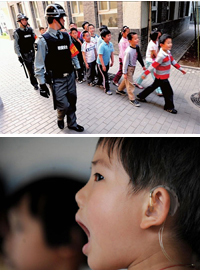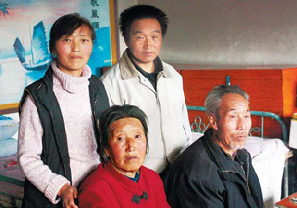PHOTO |
 China
World
Newsmaker
Slides
Weekly Photos
Share Your Photos
Special China
World
Newsmaker
Slides
Weekly Photos
Share Your Photos
Special
|
|
 |
Large Medium Small |
|
Special Coverage:China Population |
|
Editor's note: Take a breath. The number is always astonishingly huge whenever you think of China’s population. It will swell to 1.4 billion by the end of 2015, mobile users sent about 23 billion text messages during Chinese New Year in 2010, the number of Internet users in China has already reached 404 million, and unfortunately more than 24 million Chinese men of marrying age may find it difficult to find a partner by 2020. The problems behind the numbers seem to be bigger. In a poor village in East China’s Shandong province, visitors will see large white characters on a wall that say “it’s of the same to give birth to a boy and girl, and girl is also a heir,” an indication of local governments’ efforts in fighting against gender selection. In the Capital city of Beijing, the government also educates people to queue properly when taking a bus, not because the passengers behave badly but they are under pressure in finding space to stand in the crowded bus. As World Population Day is observed on July 11, the China Daily website provides special coverage of China’s population to briefly discuss the various problems in the world’s most populous country, such as the left-behind children, empty nesters, family-planning policy, the much-debated hukou policy, and younger migrant workers who have a growing sense of civil rights.
|
|
China's population set to reach 1.4 billion by 2015 China's population is projected to reach 1.4 billion by the end of 2015, when the urban population will become the majority for the first time. The first boom in China's aging population is expected over the next five years, when those aged 60 or over will top 200 million. |
350m migrant workers by 2050 |
Henan to become the first 100M population province Central China’s Henan province will become the nation’s first province with a population of 100 million people, according to the Henan Population and Family Planning Commission, Dahe News, a local newspaper reported |
|
Left-behind children |
|
Students take a nap at an elementary school in Qiannan, Southwest China's Guizhou province, May 25, 2010. Most of the 102 students in the school are separated from their parents who migrate to work in big cities and send money back. |
Five pupils attempted to commit suicide by drinking herbicide.Four of them are left-behind children in rural areas There are about 58 million children, including 40 million under the age of 14, who are left behind with senior members of the families, according to separate studies by the All- China Women's Federation and Ministry of Human Resources and Social Security |

It's hard to say whether this is the best time to be a child in China especially after a string of school attacks recently that cut deep into people’s sense of security. The following photos, all related to Chinese children, try to outline the big picture about growing up in China. |
|
Aging Society and Empty Nesters |
|
 |
|
|
New Generation of Migrant Workers |
|
|
They are nearly 100-million strong; they were born and grew up in the countryside, but they no longer share their parents' love for the land; they find their jobs in the cities, but they also find it hard to call them home; they are the so-called post-80s and post-90s generation, but they are different from their urban counterparts - they are migrant workers. A new generation of migrant workers, who are distinctive from their predecessors - their mothers and fathers: They have higher levels of education; they strive for better working conditions and wages; and they hope to be part of the city life. Still, they are migrant workers, unable to enjoy equal social rights as the urban residents. Click to see the slide |
|
 |
 |
 |
|
24 million men unable to find spouses Low birth rates of women in China may be to blame for some 24 million men failing to find a spouse in 2020, according to a report. |
Marriage, Money and Morals |
Rural healthcare system has cracks |